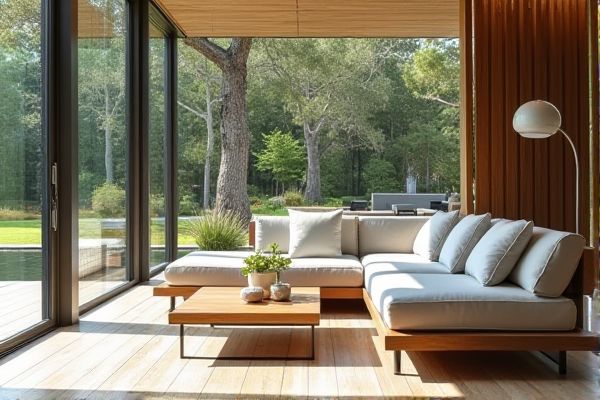
Polywood furniture offers exceptional durability and weather resistance with a low-maintenance wooden appearance, while aluminum furniture excels in lightweight strength, rust resistance, and modern design versatility. Discover which material best suits Your outdoor living needs by reading the full comparison in the article.
Table of Comparison
| Feature | Polywood Furniture | Aluminum Furniture |
|---|---|---|
| Material Composition | Made from recycled HDPE plastic, mimics wood grain | Lightweight, corrosion-resistant metal alloy |
| Durability | Weatherproof, resists rot, cracking, and splintering | Highly durable, resistant to rust and corrosion |
| Maintenance | Low maintenance, easy to clean with soap and water | Minimal maintenance, may require occasional cleaning |
| Weight | Heavier due to dense plastic materials | Lightweight and easy to move |
| Environmental Impact | Eco-friendly, uses recycled materials | Recyclable but requires energy-intensive production |
| Cost | Moderate to high initial cost, long-lasting | Varies, generally affordable and cost-effective |
| Appearance | Wood-like look with various color options | Modern, sleek, often powder-coated finish |
| Comfort | Sturdy with slight flexibility, comfortable for extended use | Firm seating, may require cushions for comfort |
Introduction to Polywood and Aluminum Furniture
Polywood furniture is crafted from high-density polyethylene recycled plastics, offering exceptional durability, resistance to moisture, and a wood-like appearance ideal for outdoor settings. Aluminum furniture features lightweight, corrosion-resistant metal frames that provide strength, minimal maintenance, and modern design versatility. Both materials excel in weather resistance and longevity, making them popular choices for outdoor furniture solutions.
Material Composition and Manufacturing
Polywood furniture is crafted from high-density polyethylene (HDPE) recycled plastics, offering resistance to moisture, rot, and insect damage, while aluminum furniture is made from lightweight, corrosion-resistant metal that undergoes processes like extrusion or casting for durability. Polywood manufacturing involves molding recycled plastic into lumber-like planks, requiring minimal maintenance and preserving eco-friendly attributes. Aluminum furniture production includes anodizing or powder coating to enhance surface protection, contributing to its longevity and rust resistance in outdoor environments.
Durability and Longevity Comparison
Polywood furniture offers exceptional durability due to its resistant synthetic lumber that withstands moisture, rot, and insect damage, making it ideal for harsh outdoor conditions. Aluminum furniture excels in longevity with its lightweight, rust-resistant properties and minimal maintenance needs, maintaining structural integrity over many years. Both materials provide long-lasting outdoor solutions, but Polywood is better suited for environments with high moisture, while aluminum is preferred where rust and corrosion resistance are critical.
Weather Resistance: Polywood vs. Aluminum
Polywood furniture offers superior weather resistance with its synthetic lumber design, resisting moisture, UV rays, and temperature fluctuations without warping or cracking. Aluminum furniture also provides excellent durability against rust and corrosion, making it lightweight and easy to maintain in various climates. When choosing your outdoor furniture, Polywood ensures long-lasting strength in harsh weather, while aluminum excels in rust-prone environments.
Maintenance Requirements and Ease of Care
Polywood furniture requires minimal maintenance, needing only occasional cleaning with soap and water to prevent dirt buildup and retain its color. Aluminum furniture offers superior resistance to rust and corrosion, making it ideal for outdoor use with simple wipe-downs to remove dust and debris. You will find that both materials provide ease of care, but Polywood's durability against fading and staining often translates to less frequent upkeep compared to aluminum.
Aesthetic Appeal and Design Options
Polywood furniture offers a classic, wood-like aesthetic with rich textures and natural color variations that enhance outdoor spaces with warmth and elegance. Aluminum furniture provides sleek, modern designs with the advantage of lightweight durability and powder-coated finishes available in a wide range of colors and styles. Both materials deliver versatile design options, but Polywood excels in traditional charm while aluminum suits contemporary minimalism.
Comfort and Usability Differences
Polywood furniture offers superior comfort due to its wood-like texture and natural warmth, making it ideal for extended seating periods. In contrast, aluminum furniture is lightweight and highly durable but can feel colder and harder, affecting long-term usability. Polywood's resistance to weather and rot ensures consistent comfort outside, whereas aluminum's heat conductivity may cause surface temperature fluctuations.
Sustainability and Environmental Impact
Polywood furniture is crafted from recycled plastics, making it highly sustainable by reducing landfill waste and lowering the demand for virgin materials. Aluminum furniture is recyclable and lightweight, but its production involves significant energy consumption and mining impacts. Your choice between the two should consider whether you prioritize recycled content and waste reduction or longevity and recyclability.
Cost Analysis: Initial Investment and Value
Polywood furniture typically requires a higher initial investment than aluminum furniture due to its durable synthetic lumber made from recycled materials, which offers weather resistance and minimal maintenance costs. Aluminum furniture, while generally more affordable upfront, may incur additional expenses over time because of potential corrosion and the need for protective coatings or frequent upkeep. Evaluating long-term value, Polywood sets a cost-effective advantage through its extended lifespan and sustained aesthetic appeal, whereas aluminum furniture offers affordability with potentially higher recurring maintenance investments.
Best Use Cases: Which Furniture Suits Your Needs?
Polywood furniture excels in outdoor environments requiring durability against weather, making it ideal for patios, gardens, and poolside settings due to its resistance to moisture, fading, and insects. Aluminum furniture offers lightweight portability and sleek modern design, perfect for spaces needing easy rearrangement or storing, such as balconies and small outdoor cafes. Your choice depends on whether you prioritize longevity and low maintenance with Polywood, or flexibility and contemporary style with aluminum.
 homyna.com
homyna.com